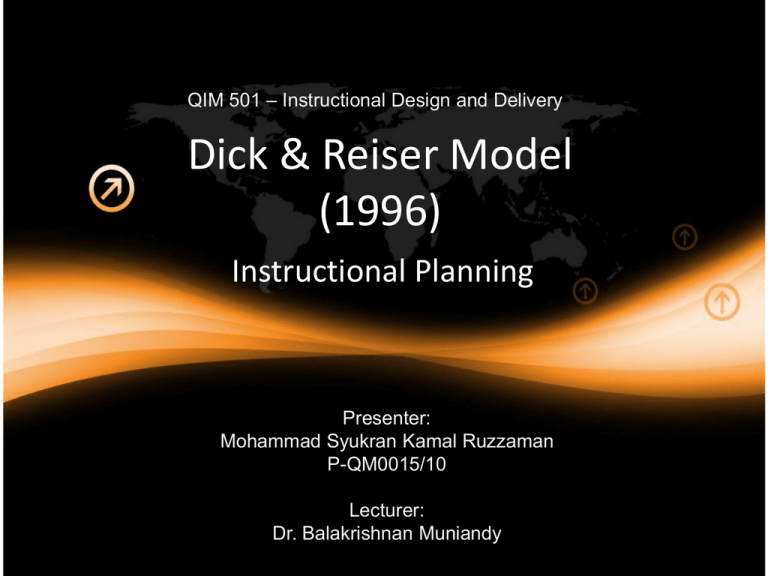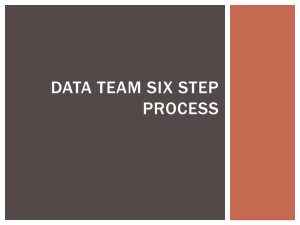
QIM 501 – Instructional Design and Delivery
Dick & Reiser Model
(1996)
Instructional Planning
Presenter:
Mohammad Syukran Kamal Ruzzaman
P-QM0015/10
Lecturer:
Dr. Balakrishnan Muniandy
Background of the Proponents
Walter Dick
Robert A. Reiser
Background of the Proponents
• Ph.D. Arizona State University
Specialization: Educational Technology
• Degree received August, 1975 M.A. Arizona
State University
Specialization: School Library Media
Degree received August, 1974
• B.A. Queens College of the City University of
New York
Major: Economics
Minor: Secondary Education Degree received
June, 1970
http://www.ibstpi.org/AboutUs/directors/rreiser.html
Background of the Proponents
• PhD from Penn State University in
Educational Psychology
• Emeritus Professor from Florida State
University
• Is currently an Adjunct Assistant
Professor at Penn State University
http://insys.fsu.edu/People_fac.htm
Dick & Reiser ID Model (1996)
Identify
Goal
Identify
Objective
Plan
Activities
Choose
Meda
Revise Instruction
Develop
Assessment
Tools
Implement
Instruction
The Purpose
• Dick & Reiser (1996) model is an instructional
design (ID) model. All ID models have the
same general purposes:
– Analysis of learners’ needs and context analysis
– Design a set of specifications to create an effective,
efficient, and relevant learner environment
– Develop all learner and management materials
– Implement the instructions.
– Evaluate the results of the development process
(formative) and end product (summative)
The Purpose
• Instruction in classroom or any learning
environment.
• Serve as conceptual and communication tools
for analyzing, designing, creating, and
evaluating guided learning ranging from broad
educational environments to narrow training
functions
The Purpose
• ID models help us to conceptualize
representations of reality.
• A model is a simple representation of more
complex forms, processes, and functions of
physical phenomena or ideas.
• As a guide for teachers to design the best
instruction so that the learning can take place.
Before implementing the model
Audiences and prerequisites
• Students differ in terms of background of
experience, attitudes, abilities, needs, motivation,
knowledge, and other factors. Instruction must be
designed with these matters in mind.
• Are your students highly motivated toward further
study in it? Do they already know and care quite a lot
about your subject, and do they have attitudes about
it?
Before implementing the model
Audiences and prerequisites
• Determination of the target audience will lead to
identification of prerequisites.
• Are certain prior knowledge and abilities necessary
for achieving the goals of your class?
• Do the goals need to be adjusted in terms of the
audience?
Dick & Reiser ID Model (1996)
Identify
Goal
Identify
Objective
Plan
Activities
Choose
Meda
Revise Instruction
Develop
Assessment
Tools
Implement
Instruction
Identify
Goal
Identify
Objective
Plan
Activities
Choose
Module
Develop
Assessment
Tools
Implement
Instruction
Revise Instruction
Identify instructinal goal
• A systematic, or instructivist, approach to instruction
has been shown to be an effective model due to its
focus on clearly identifying goals and systematically
developing instructional activities and assessment
that lead to the attainment of the goals (Reiser &
Dick, 1996)
Identify
Goal
Identify
Objective
Plan
Activities
Choose
Module
Develop
Assessment
Tools
Implement
Instruction
Revise Instruction
Identify instructinal goal
• A goal
– general statements of what you would like for
students to be able to do when they complete your
course.
• Example :
– For the first grade math student the goal is
“Students should be able to solve basic addition problems.
– For teachers :
“Teacher should be able to construct ten structured
question using Hot Potatoes Software
Identify
Goal
Identify
Objective
Plan
Activities
Choose
Module
Develop
Assessment
Tools
Implement
Instruction
Revise Instruction
Identify learning objectives
• Objectives are specific statements of what
students will be able to do as a result of you
instruction which will contribute to their
reaching the goals(s)
•
Objectives are steps to achieve main goal(s)
Identify
Goal
Identify
Objective
Plan
Activities
Choose
Module
Develop
Assessment
Tools
Implement
Instruction
Revise Instruction
Identify learning objectives
Instructional goal:
Explain the process of photosynthesis
Objective 1:
Define
photosynthesis
Objective 2:
State the
requirements of
photosynthesis.
Objective 3:
List down the
outcome of
photosynthesis
Objective 4:
Explain what are
he factors in
photosynthesis
Identify
Goal
Identify
Objective
Plan
Activities
Choose
Module
Develop
Assessment
Tools
Implement
Instruction
Revise Instruction
Identify learning objectives
Instructional goal:
Teachers will be able to use Hot Potatoes Software to
construct structured questions
Objective 1:
Install the
software
Objective 2:.
Create a JCloze
document
Objective 3:
Construct 10
structured
question
Objective 4:
Save the
document
Identify
Goal
Identify
Objective
Plan
Activities
Choose
Module
Develop
Assessment
Tools
Implement
Instruction
Revise Instruction
Identify learning objectives
• If students achieve all of the objectives, but have not
reached their goals, then there is something wrong
with the objectives.
• On the other hand, if students have not met all of
their objectives, but have reached their goals, some
of the objectives were not necessary.
Identify
Goal
Identify
Objective
Plan
Activities
Choose
Module
Develop
Assessment
Tools
Implement
Instruction
Revise Instruction
Planning instructional activities
•
•
Instructional activities are those activities which
help to meet the objectives and, eventually the
goal(s).
Activities that provide opportunity to students to
explore within a domain, integrating their new
knowledge with knowledge and attitudes which
they brought with them in order to "construct their
own meaning."
Identify
Goal
Identify
Objective
Plan
Activities
Choose
Media
Develop
Assessment
Tools
Implement
Instruction
Revise Instruction
Planning instructional activities
•
•
Activities may consist of anything from reading to
listening to participating in field trips to exploring
the Internet
They may be developed by the instructor, or with
knowledge of the students’ background, needs,
abilities, etc. (Reser & Dick)
Identify
Goal
Identify
Objective
Plan
Activities
Choose
Media
Develop
Assessment
Tools
Implement
Instruction
Revise Instruction
Choose instructional media
•
•
Instructional media include lecturing, assignments,
using presentation packages such as PowerPoint,
the Internet, computer-assisted-instruction
packages, and others.
The problem is to discover which helps most in
meeting objectives, and that may not be the same
for all students.
Identify
Goal
Identify
Objective
Plan
Activities
Choose
Media
Develop
Assessment
Tools
Implement
Instruction
Revise Instruction
• Practicality: Is the intended media practical in that the
media is available, cost efficient, time efficient, and
understood by the instructor?
• Student Appropriateness: Is the intended media
appropriate for the developmental and experiential
levels of the students?
• Instructional Appropriateness: Is the intended media
appropriate for the planned instructional strategy? Will
the media facilitate the students’ acquisition of the
specific learning objectives?
Identify
Goal
Identify
Objective
Plan
Activities
Choose
Media
Develop
Assessment
Tools
Implement
Instruction
Revise Instruction
Develop Assessment Tools
• Assessment tools must be designed to
provide students with the opportunity to
demonstrate the skills, knowledge, and
attitudes stated in the objectives.
Identify
Goal
Identify
Objective
Plan
Activities
Choose
Media
Develop
Assessment
Tools
Implement
Instruction
Revise Instruction
Implement instruction
• Implementation gives instructor the
opportunity to assess the effectiveness of the
plan of instruction.
• In real situation
Identify
Goal
Identify
Objective
Plan
Activities
Choose
Media
Develop
Assessment
Tools
Implement
Instruction
Revise Instruction
Revise Instruction
• Any plan should be subject to revision, and the
revision should go clear back to the objectives.
• Usually we do not wish to change the actual goals for
a course, but
–
–
–
–
the objectives may not be actually helping to meet the goal
the activities may not be helping to meet the objectives,
the medial may not be the most efficient means of delivery,
the assessment may not actually provide the opportunities
to demonstrate meeting the objectives.
Dick and Reiser Model (1989)
References
Cher Ping Lim and Ching Sing Chai Rethinking Classroomoriented Instructional Development Models to mediate
Instructional Planning in Technology-enhanced Learning
Environments
• Amy L. Baylor A Comparative Analysis and Validation of
Instructivist and Constructivist Self-Reflective Tools (IPSRT and
CPSRT) for Novice Instructional Planners
• Kristin Koepke and Bill Cerbin Writing Course Objectives
• Jennifer Summerville and Angelia Reid-Griffin Technoogy
Intergration and Instrucional Design
References
http://www.umdnj.edu/idsweb/idst5330/instructional_media.ht
m
http://tecfa.unige.ch/staf/staf9698/mullerc/3/evalRD.html
http://pipl.com/search/?FirstName=Dick&LastName=Reiser&Cit
y=&State=&Country=&CategoryID=2&Interface=46
http://www.ericdigests.org/1998-1/survey.htm
http://tecfa.unige.ch/staf/staf9698/mullerc/3/evalRD.html







